Author: Biteye core contributor Viee
Editor: Biteye core contributor Crush
Today, the main board opened lower and closed down 6 points, cooling down the recent market heat.
How crazy is the stock market? I believe everyone has witnessed it.
The Shanghai Composite Index experienced a "miracle" rally of over 600 points in 9 trading days before the holiday.
After the holiday, the three major indices collectively opened higher, with gains all exceeding 10%.
Trading volume exceeded 3.45 trillion yuan, setting a new historical high.
Foreign capital rushed in to join the "shopping spree".
The Hang Seng Index has risen 35.5% so far this year, leading the global major stock markets.
The highest single-stock gain in the Hong Kong stock market once reached 730%, comparable to the on-chain meme coins in the crypto market!
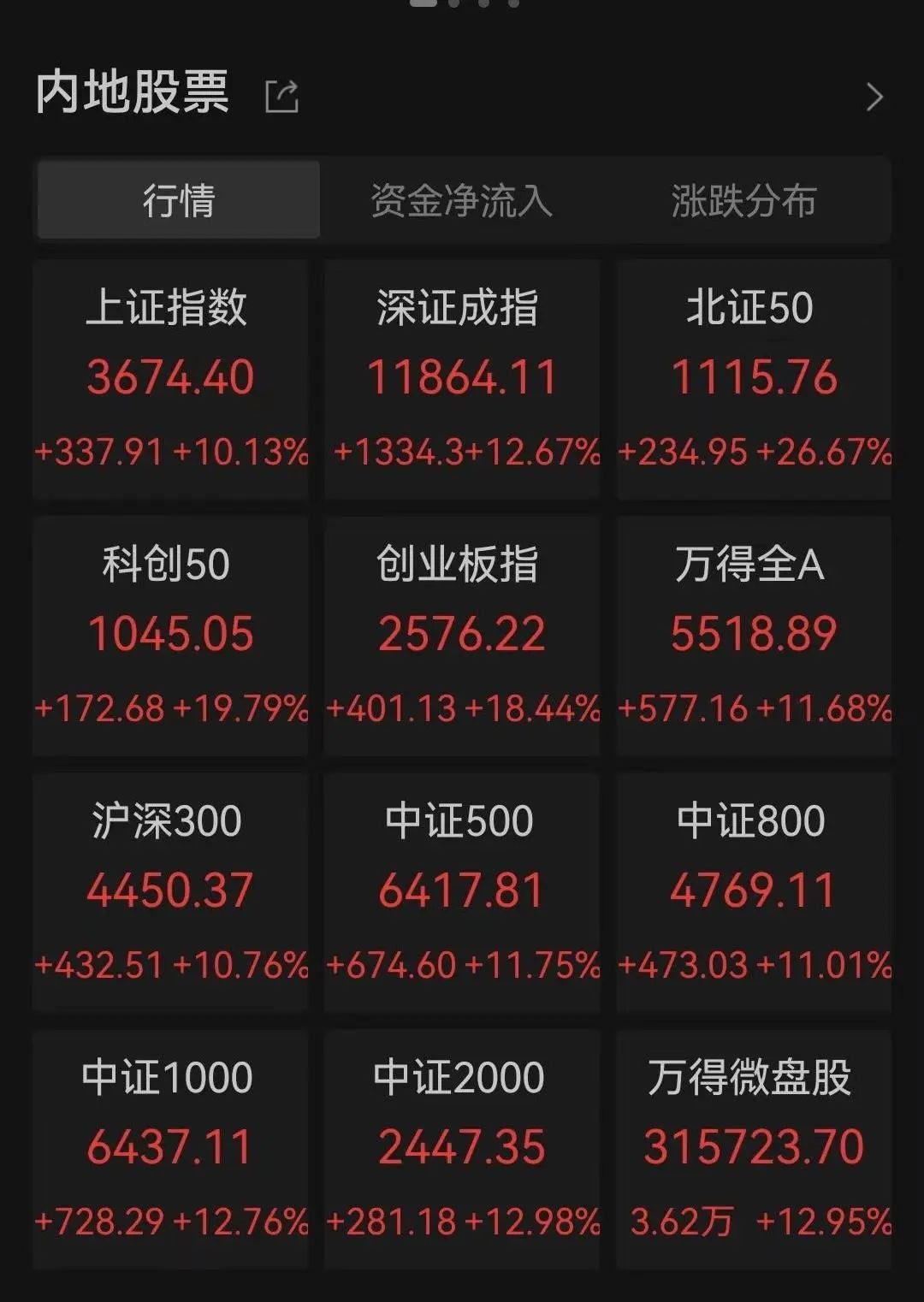
The crypto market has also ridden on this wave of heat:
The largest stablecoin in the crypto market, USDT (Tether), has been sold off to the point of trading at a discount.
It seems to have become a "hot potato" that investors are eager to exchange back into fiat currency.
Unexpectedly, the headline linking the A-shares and the crypto market is——A-shares sucking blood from the crypto market
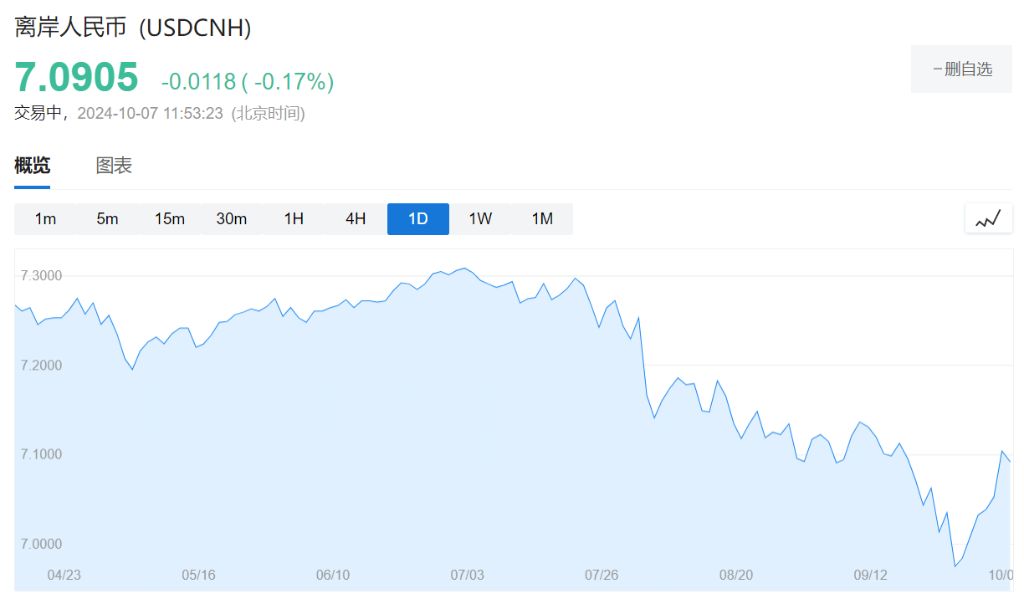
01 Current state of the A-share market: Surging tide
On the first trading day after the holiday, the A-share market was exceptionally hot, with the three major indices collectively rising. In just 20 minutes after the opening, the trading volume exceeded 1 trillion yuan, breaking the 10% gain at the opening, with more than 5,000 stocks rising, including nearly 1,000 hitting the daily limit, and the brokerage stocks soaring across the board...
This grand market trend not only made investors' hearts race, but also sparked heated discussions in various circles about the future market trend. How did the A-shares, which had repeatedly defended the 3,000-point line, suddenly become so promising?
At one point, the weak economic data and lack of market confidence had plunged the A-shares into a slump, but with the strong policy support and the recovery of market sentiment, the market has also made a strong response.
So, in this round of rise, what signals indicate the arrival of a bull market in the A-shares?
Unprecedented policy strength: On September 24, the central bank and the regulatory authorities jointly issued a package of easing policies, showing a strong intention to support the market. The governor's Panggongsheng's statement of "another 5,000 billion after the first 5,000 billion" injected a strong tonic into the market.
Trading volume hitting a new high: On October 8, the trading volume reached 3.45 trillion yuan, not only refreshing the historical record, but also indicating a significant increase in market activity. High trading volume is usually an important signal of the arrival of a bull market, reflecting investors' optimistic expectations for the market outlook.
Incremental inflow of foreign capital: Since the policy was released, Chinese concept stocks have generally risen, and many foreign institutions have expressed their optimism about the Chinese stock market. This influx of capital has injected new momentum into the market.
Overall valuation still at a low level: The current overall valuation of the A-shares is still relatively low, with the valuation percentile of the ChiNext Index below 8%, providing opportunities for medium and long-term layout.
Brokers working overtime to solicit clients: The number of new accounts opened by investors is also surging. Data shows that on September 27, the net value of investors' bank-securities transfers reached 7.04, a three-and-a-half-year high. Brokers even temporarily opened services during the National Day holiday to meet the needs of investors.
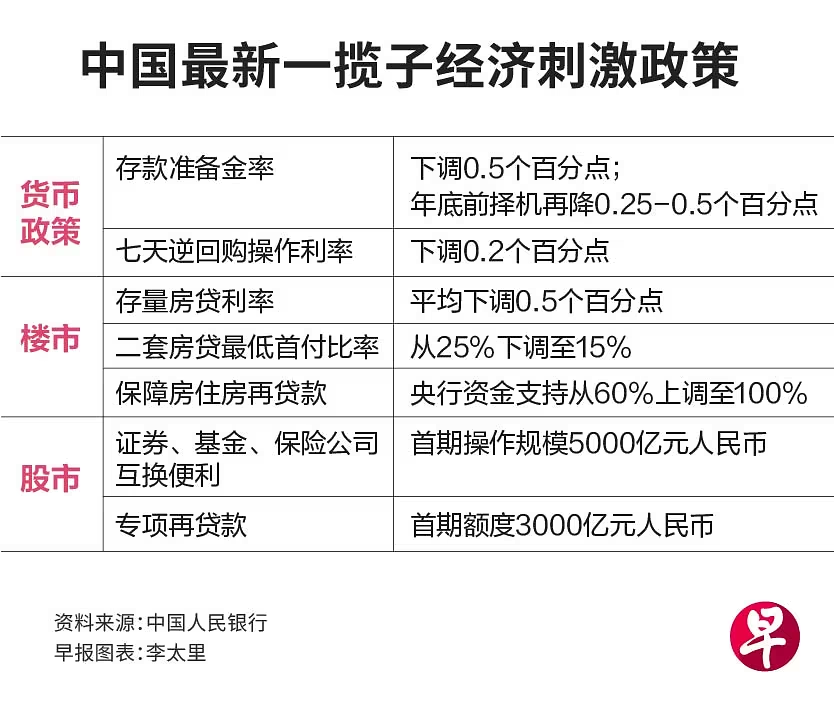
02 Current state of the crypto market: Undercurrents
While the A-share market is hot, the crypto market seems a bit sluggish. BTC rose to a 2-month high of $66,500 on September 27, but has since been fluctuating downward, falling to around $60,000 by early October.
Is the crypto market brewing new opportunities? When will the bull market start? We can pay attention to the following signals:
Macroeconomic and policy changes
Recently, the Federal Reserve announced a sharp 50-basis-point rate cut, and the influx of liquidity has driven an overall rise in the crypto market. Loose monetary policy is generally considered beneficial for speculative assets like cryptocurrencies, so the market is optimistic about the future trend.
Continuous inflow of incremental capital
The inflow of incremental capital is one of the important indicators for judging the crypto bull market.
ETF
The net inflow of Bitcoin spot ETFs has a very significant impact on the price. Sustained net inflows indicate that market demand for Bitcoin is increasing, and this positive sentiment is often reflected in the price, causing it to remain stable or rise.
On the contrary, if there is a large net outflow, it may put downward pressure on the Bitcoin price. The outflow of funds usually means a lack of investor confidence, which may lead to price declines. Therefore, the capital flow of spot ETFs is an important indicator for investors to judge the market trend.
Over the past month, Bitcoin spot ETFs have had net outflows on only 6 days, and the magnitude has been smaller than before. Currently, after a period of price fluctuations and declines, off-chain capital confidence is gradually recovering.
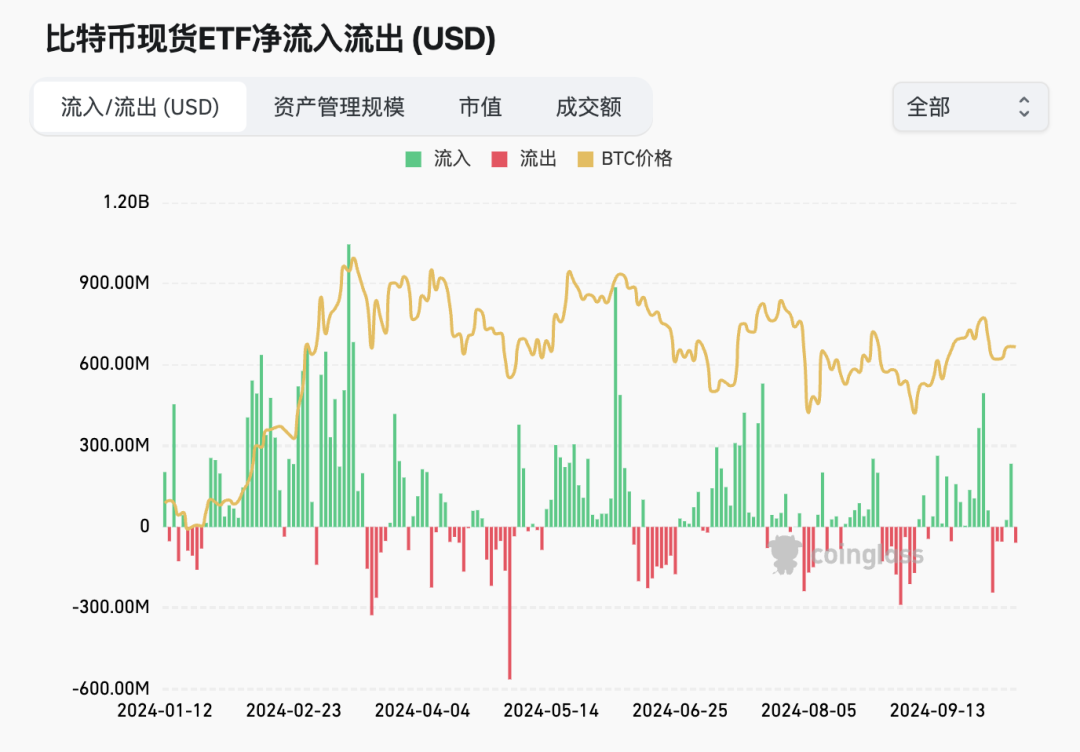
Data source: Coinglass
Stablecoins
The market capitalization of stablecoins to some extent reflects the inflow of incremental capital. In the crypto market, when users buy stablecoins with fiat currency, these funds will flow into the market, driving the market capitalization of stablecoins to rise. Observing the changes in the market capitalization of stablecoins can help judge the capital flow in the market.
As shown in the figure below, the total market capitalization of stablecoins surged to $168 billion in August, surpassing the $167 billion record in March 2022, setting a new high. Currently, the total market capitalization of stablecoins is still constantly breaking new highs, with the latest data on October 8 being $171.3 billion.
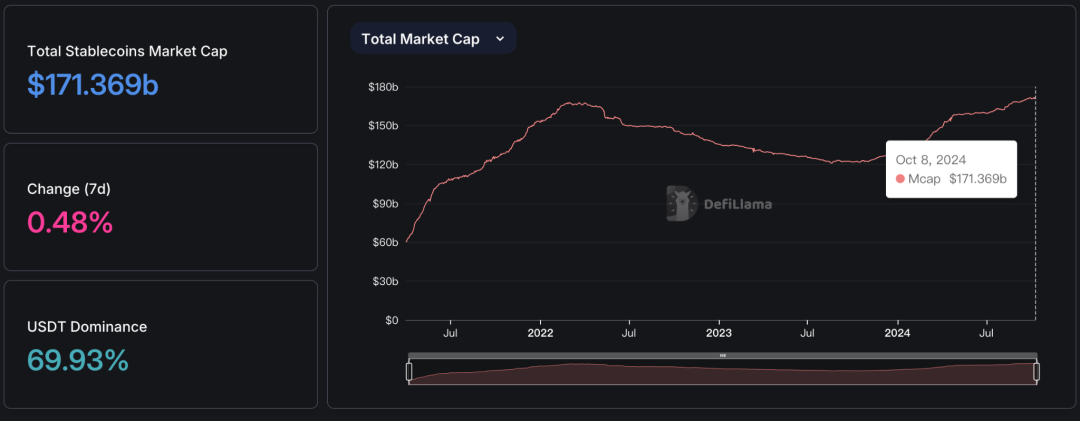
Data source: Defillama
The total market capitalization of fiat-backed stablecoins has also reached a new high and is still growing. This data only includes fiat-backed stablecoins and does not involve those algorithmic stablecoins that rely on complex algorithms. As shown in the figure below:
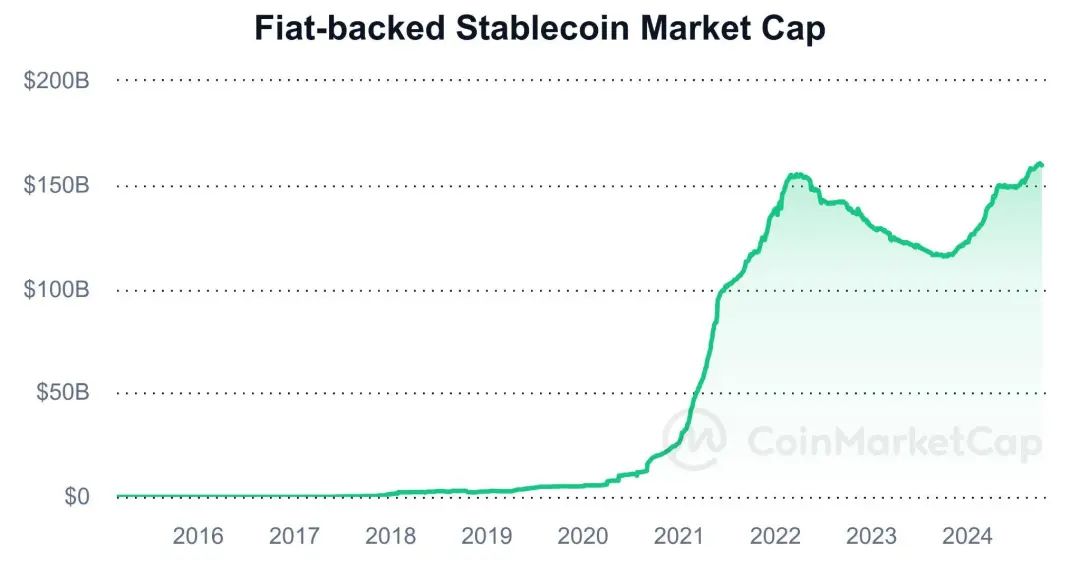
Data source: CoinMarketCap
It is worth mentioning that currently, Tether (USDT) ranks first with a market capitalization of nearly $119.6 billion, accounting for nearly 70% of the total stablecoin market capitalization. USD Coin (USDC) is closely behind, also growing steadily, with a market capitalization of about $35.3 billion. As market confidence recovers, the continued demand for these two stablecoins will also increase. The chart below shows the changes in USDT's market capitalization.
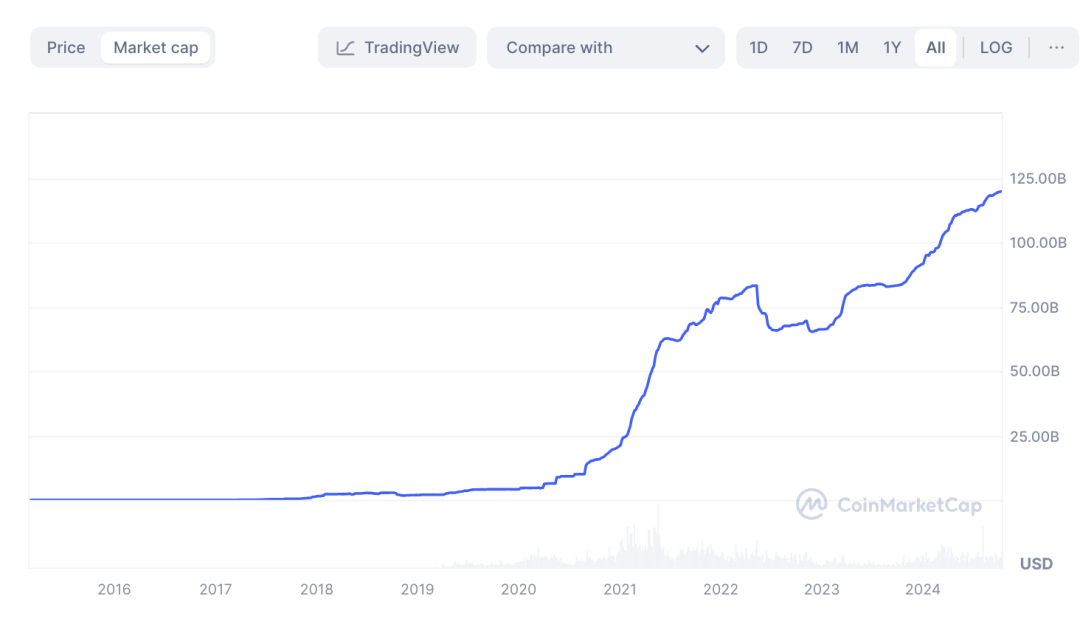
Data source: CoinMarketCap
The Merrill Lynch clock cycle
The Merrill Lynch clock is an important tool for evaluating the relationship between the economic cycle and asset performance, dividing the economic cycle into four stages: recession, recovery, overheating, and stagflation.
Recession period:
Characteristics: Slow or stagnant economic growth, low inflation rate.
Investment strategy: Bonds perform best at this time, as interest rates fall and fixed income becomes attractive to investors.
Recovery period:
Characteristics: The economy begins to warm up, growth accelerates, and inflation remains at a relatively low level.
Investment strategy: Stocks become the best investment choice, as corporate earnings improve and market confidence strengthens.
Overheating period:
Characteristics: The economy continues to grow strongly, but inflation rises.
Investment strategy: Stocks still have relatively strong allocation value, commodities perform outstandingly, and investors may face the risk of rate hikes.
Stagflation period:
Characteristics: Economic growth is below potential, and inflation remains high.
Investment strategy: Holding cash is the best choice, as other assets have not performed well.
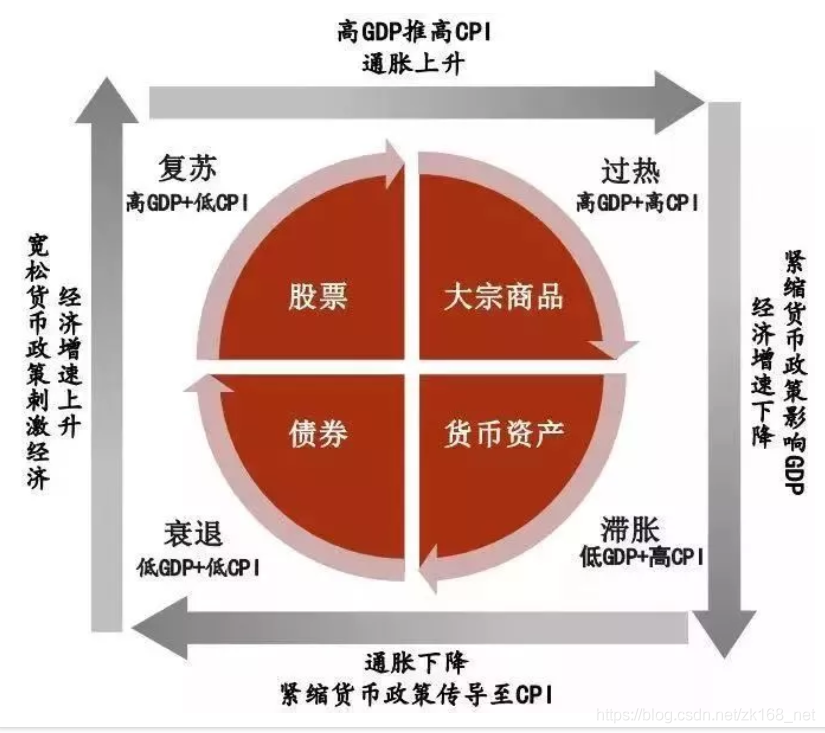
As a risk asset, cryptocurrency capital usually flows into the crypto market during the recovery and overheating periods of the Merrill Lynch clock. The reason is that during the recovery period, market confidence gradually recovers, capital inflows increase, and cryptocurrencies as high-risk assets are favored, often leading to price increases. Although the economy is growing strongly during the overheating period, inflation is rising, and investors' demand for cryptocurrencies like Bitcoin is increasing, which may lead to a rapid price increase.
Therefore, when the market is in these two stages, the possibility of a Bitcoin bull market is relatively high. On September 18, the Federal Reserve announced a sharp 0.5% rate cut. The United States has entered a rate cut cycle. From the Merrill Lynch clock, we are currently in the transition from recession to recovery, and the bull market may be just around the corner.
In addition, according to Bloomberg data, the correlation coefficient between cryptocurrencies and the MSCI World Stock Index is close to 0.6, which is one of the highest levels in the past two years. This indicates that the trends of the two markets are becoming increasingly similar, and when the stock market performs well, the cryptocurrency market may also rise accordingly.
On-chain data indicators
Bitcoin Rainbow Price Chart
The Rainbow Chart is a long-term valuation tool for Bitcoin, using a logarithmic growth curve to predict the potential future price direction of Bitcoin. The warmer colors at the top indicate when the market may be overheated, which is a relatively good time to sell; the cooler colors indicate that the overall market sentiment is usually depressed, which is a relatively good time to buy. By using the Rainbow Chart, you can assist in judging the arrival of bull market signals.
There are a total of 10 color bands in the chart. For example, on October 8th, BTC is in the green "buy" zone, and the market heat is generally moderate. If one day BTC's price is in the yellow, orange, or red bands of the Rainbow Chart, it means that the market is gradually heating up, and the bull market signals are becoming more and more obvious.
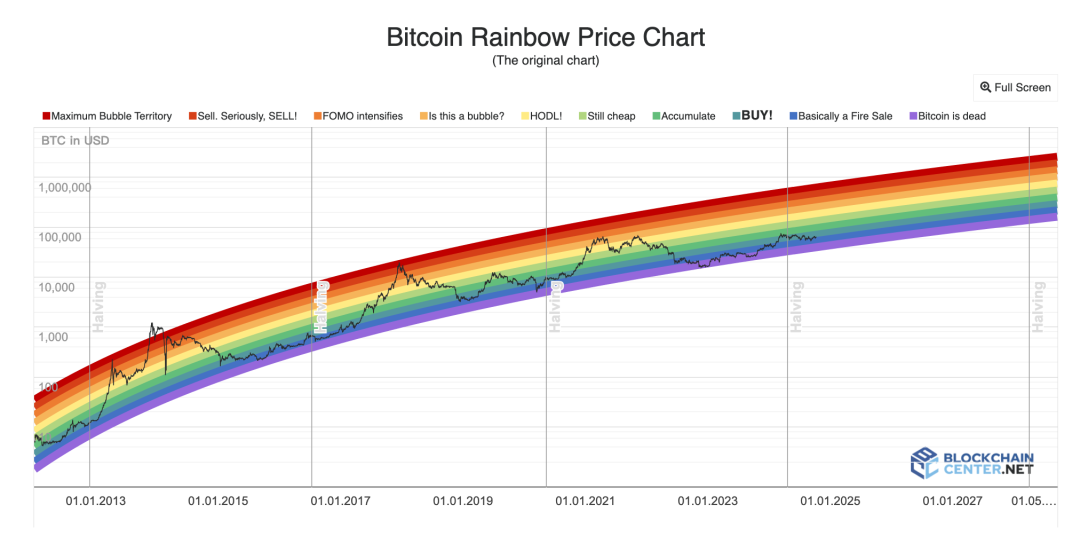
For more analysis on on-chain data indicators, you can refer to the recent article of Biteye: 《Buy the Dips? 7 Bitcoin Bottom Fishing Indicators》
03 Summary
Over the past two weeks, capital has been pouring into the Chinese stock market. All In A-shares, which no longer seems to be the laughing stock of the capital market.
In comparison, although the crypto market is currently lacking in momentum, if we take a long-term view, Bitcoin is still the best performer among all asset classes this year. According to the latest statistics from Goldman Sachs on October 8th, Bitcoin has risen more than 40% this year, outperforming major stock indices, fixed-income securities, gold, and oil.
When will the crypto bull market come? It's a matter of both sentiment and facts.
By observing and tracking a series of positive signals, accompanied by global economic recovery and policy support, we believe that the crypto bull market is just around the corner!







